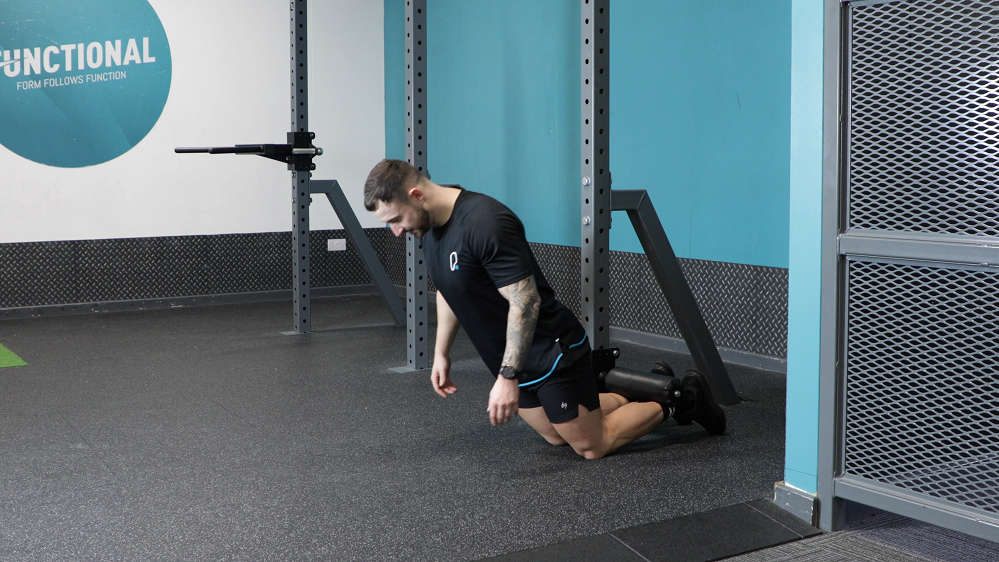Nordic Curls
What Is A Nordic Curl?

Choose a dumbbell that allows you to move through your entire range of motion with control, instead of relying on momentum to lift the weight. As you get stronger you can increase the weight.
Place the dumbbell on the floor resting on one end so you can easily pick it up with your feet.
When you perform the hamstring curl, stop when the dumbbell is parallel (do not bring it right in to your glutes).
At the bottom of the movement, let the dumbbell touch the floor lightly before starting the next rep.Jump straight to instructions
Nordic curls, also known as Russian hamstring curls, are a challenging bodyweight hamstring exercise that focuses on the lowering portion of the movement to strengthen the hamstrings. Nordic curls build eccentric strength and can improve hamstring flexibility. Adding Nordic curls into your routine can help to protect against hamstring injuries, making them a great choice for runners and sports players.
Like other hamstring exercises, Nordic curls build strength in the hamstrings, glutes, and lower back. What's different about Nordic curls is that you hinge at the knee and focus on the eccentric phase of lengthening your legs.
Nordic curls are an equipment-free exercise, all you need is something stable to hold your feet in place. You could use a Smith machine or ask your training partner to hold your feet.
Nordic curls are an intermediate-level hamstring exercise that can take a bit of time to learn. Start by reducing the range of movement by using your hands as support until you are confident to lower to the floor.
Check out some other hamstring curl variations: Lying leg curls, Swiss ball hamstring curls, seated leg curl, banded hamstring curl, dumbbell hamstring curl
Commonly Asked Questions About Nordic Curls
Nordic curls are not bad for your knees. If you feel any pressure on your knees, kneel on an exercise mat or cushion to add a layer between your knees and the floor.
You can do Nordic curls at home by anchoring your feet under any sturdy and stable point such as the edge of the sofa. Alternatively, ask someone to hold onto your feet to keep them still throughout the exercise.
Nordic hamstring curls are an effective hamstring exercise that focuses on the eccentric phase of the movement as you lower down towards the floor. Eccentric exercises are good for building strength and muscle mass and can help to protect against injuries.
Nordic curls are more challenging than they look, so make sure you can do one rep with perfect form before you do more. Once you are able to do Nordic curls with good technique, aim for 8-10 reps but always stop when you feel your form failing.
Nordic curls are a hamstring exercise that strengthen and stretch the hamstrings and can help protect against hamstring injuries.
Nordic Curl Tips
Hook your feet under a stable anchor point that holds your feet by the toes or ankles.
If you don't have access to a stable anchor point, ask a training partner to hold your feet still as you perform Nordic curls.
Keep your body in a straight line from your head to your knees, and hinge from the knees.
Use your hands to support yourself as you progress the Nordic curl movement.
How To Do Nordic Curls
Kneel on a padded mat or cushion. Secure your feet and ankles underneath your anchor point, or ask your training partner to hold your feet from behind.
Your knees should be hip width with your feet directly behind your knees. Your torso and shoulders should be in line with your hips.
Keep your arms by your sides, and chin tucked slightly in to your chest to keep your spine neutral.
Engage your core and squeeze your glutes and hamstrings as you slowly lower your torso towards the ground. Hinge from the knees to keep your body in a straight line from knees to head.
Go as far as you can using only your legs, then put your hands on the floor in front of your chest to add assistance.
Take your chest to the floor, keeping your body in a straight line from head to knees.
Reverse the movement by squeezing through your hamstrings to pull your body up, using your hands for assistance if necessary.
If you’re not sure if any of the above exercises are suitable for you, please consult your doctor before you start it. Need guidance on how to perform the exercise? Ask a personal trainer at your gym.